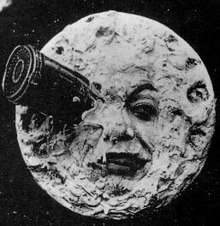Miniature effect
A miniature effect is a special effect created for motion pictures and television programs using scale models. Scale models are often combined with high speed photography or matte shots to make gravitational and other effects appear convincing to the viewer. The use of miniatures has largely been superseded by computer-generated imagery in the contemporary cinema.

Where a miniature appears in the foreground of a shot, this is often very close to the camera lens — for example when matte painted backgrounds are used. Since the exposure is set to the object being filmed so the actors appear well lit, the miniature must be over-lit in order to balance the exposure and eliminate any depth of field differences that would otherwise be visible. This foreground miniature usage is referred to as forced perspective. Another form of miniature effect uses stop motion animation.
Use of scale models in the creation of visual effects by the entertainment industry dates back to the earliest days of cinema. Models and miniatures are copies of people, animals, buildings, settings and objects. Miniatures or models are used to represent things that do not really exist, or that are too expensive or difficult to film in reality, such as explosions, floods or fires.[1]
From 1900 to the mid-1960s
French director Georges Méliès incorporated special effects in his 1902 film Le Voyage dans la Lune (A Trip to the Moon) — including double-exposure, split screens, miniatures and stop-action.[2]
Some of the most influential visual effects films of these early years such as Metropolis (1927), Citizen Kane (1941), Godzilla (1954) The Ten Commandments (1956).[3] The 1933 film King Kong made extensive use of miniature effects including scale models and stop-motion animation of miniature elements.
From the mid-1960s
The use of miniatures in 2001: A Space Odyssey[4] was a major development. In production for three years, the film was a significant advancement in creating convincing models.
In the early 1970s, miniatures were often used to depict disasters in such films as The Poseidon Adventure (1972), Earthquake (1974) and The Towering Inferno (1975).
The resurgence of the science fiction genre in film in the late 1970s saw miniature fabrication rise to new heights in such films as Close Encounters of the Third Kind, (1977), Star Wars (also 1977), Alien (1979), Star Trek: The Motion Picture (1979) and Blade Runner (1982). Iconic film sequences such as the tanker truck explosion from The Terminator (1984) and the bridge destruction in True Lies (1994) were achieved through the use of large-scale miniatures.
Largely replaced by CGI
The release of Jurassic Park (1993) was a turning point in the use of computers to create effects for which physical miniatures would have previously been employed.
While the use of computer generated imagery (CGI) has largely overtaken their use since then, they are still often employed, especially for projects requiring physical interaction with fire, explosions or water.[5]
Independence Day (1996), Titanic (1997), Godzilla (1998), The Star Wars prequel trilogy[6][7][8] (1999-2005), The Lord of the Rings trilogy (2001-3), Casino Royale (2006), The Dark Knight[9] (2008), Inception (2010), and Interstellar[10] (2014) are examples of highly successful films that have utilized miniatures for a significant component of their visual effects work.
Techniques
- Carpentry
- Plastic Fabrication
- Vacuum Forming
- Mold Making and Casting
- Fiberglass
- Welding
- Rapid Prototyping
- Laser Cutting
- Acid Etching Metal
- Machining
- Kit-Bashing
- Miniature Lighting and Electronics
- Painting
- Motion Control Photography
Notable model-makers
- Steve Gawley Star Wars,[11] Raiders of the Lost Ark
- Greg Jein: Close Encounters of the Third Kind, Star Trek: The Next Generation
- David Jones: Star Wars, The Hunt for Red October
- Michael Joyce: The Terminator, Independence Day
- Patrick McClung: The Empire Strikes Back, Aliens, The Abyss, True Lies
- Lorne Peterson: Star Wars,[12] War of the Worlds
- Brick Price: The Abyss
- Mark Stetson Blade Runner, Die Hard, The Fifth Element, The Lord of the Rings
- Richard Taylor: The Lord of the Rings, Master and Commander: The Far Side of the World
- Lorne Peterson Star Wars Episodes 1 - 6, Raiders of the Lost Ark, Battlestar Galactica.
- Grant McCune: Star Wars, Battlestar Galactica, Star Trek: The Motion Picture.
- Ian Hunter The Dark Knight, Live Free or Die Hard, The Chronicles of Narnia: The Lion, the Witch and the Wardrobe
- Matthew Gratzner: The Aviator, The Good Shepherd, Pitch Black, Alien Resurrection.
- Silas Puls
- Daniel French
- Leigh Took: The Da Vinci Code, The Imaginarium of Doctor Parnassus
Miniature effects companies
- Cinema Production Services
- Surpreeze
- Fantasy II Film Effects
- Grant McCune Design
- New Deal Studios
- Vision Crew Unlimited
- Weta Workshop
- WonderWorks
- Magicon GmbH
- Mattes & Miniatures Visual Effects (UK)
References
- Visual Effects | Activity 1 | Teacher's Resource Guide | YMI, Ltd./AMPAS Archived September 5, 2008, at the Wayback Machine
- Chmielewski, Dawn (May 21, 2006). "A medium in motion". Los Angeles Times.
- "Motion Picture Directing".
- VES Unveils “50 Most Influential Visual Effects Films of All Time”
- "Miniatures In a Digital World". Digitalcontentproducer.com. Retrieved 2013-02-03.
- "The Incredible Invisible Star Wars Prequels Miniatures". 2 June 2014.
- "PT - Practical Effects in the Prequels- Sets, Pictures, Models, etc".
- https://www.theverge.com%2F2014%2F6%2F3%2F5775976%2Fstar-wars-prequels-miniatures-photos&ei=Qdc7VdzrC8WvggTMhIHABQ&usg=AFQjCNFmGaDv9rYJnz6dj5UH4mGo4JCyHQ&bvm=bv.91665533,d.eXY
- "Miniature Dark Knight Physics, 50 Coraline Boxes, & The Digital Pitts..." Vfxplanet.vox.com. Archived from the original on 2010-02-06. Retrieved 2013-02-03.
- "See the Incredible Interstellar Miniature Models - /Film". 12 December 2014.
- "Biography | Steve Gawley". Star Wars. Archived from the original on 2008-06-20. Retrieved 2013-02-03.
- "Biography | Lorne Peterson". Star Wars. Archived from the original on 2008-06-05. Retrieved 2013-02-03.